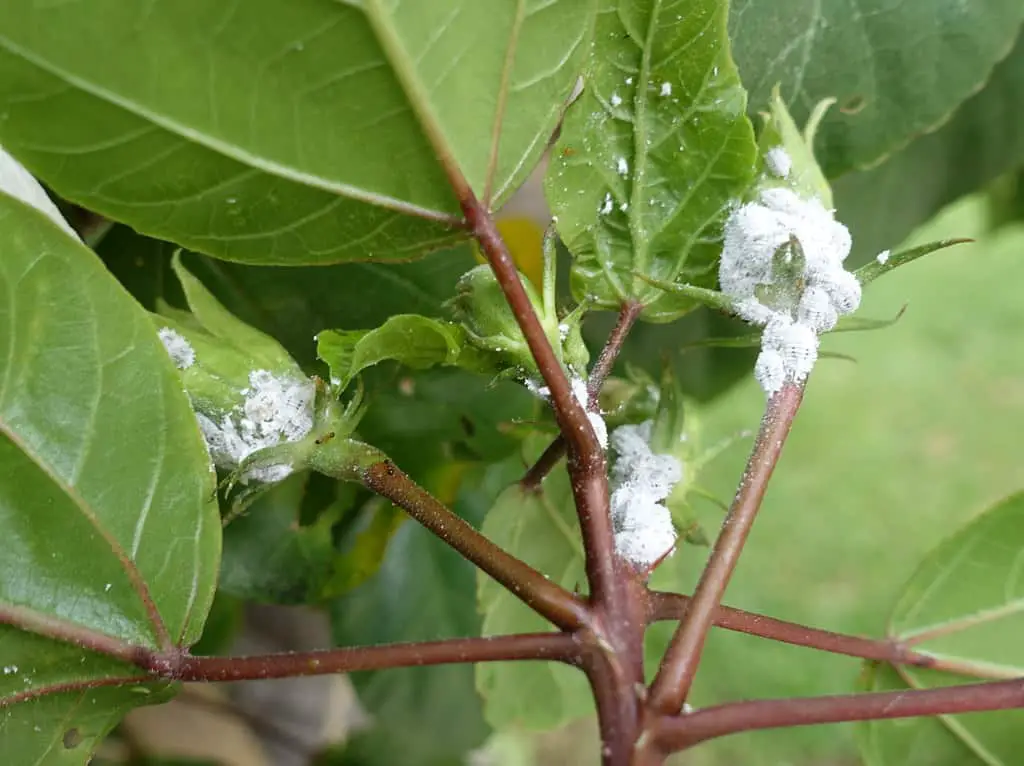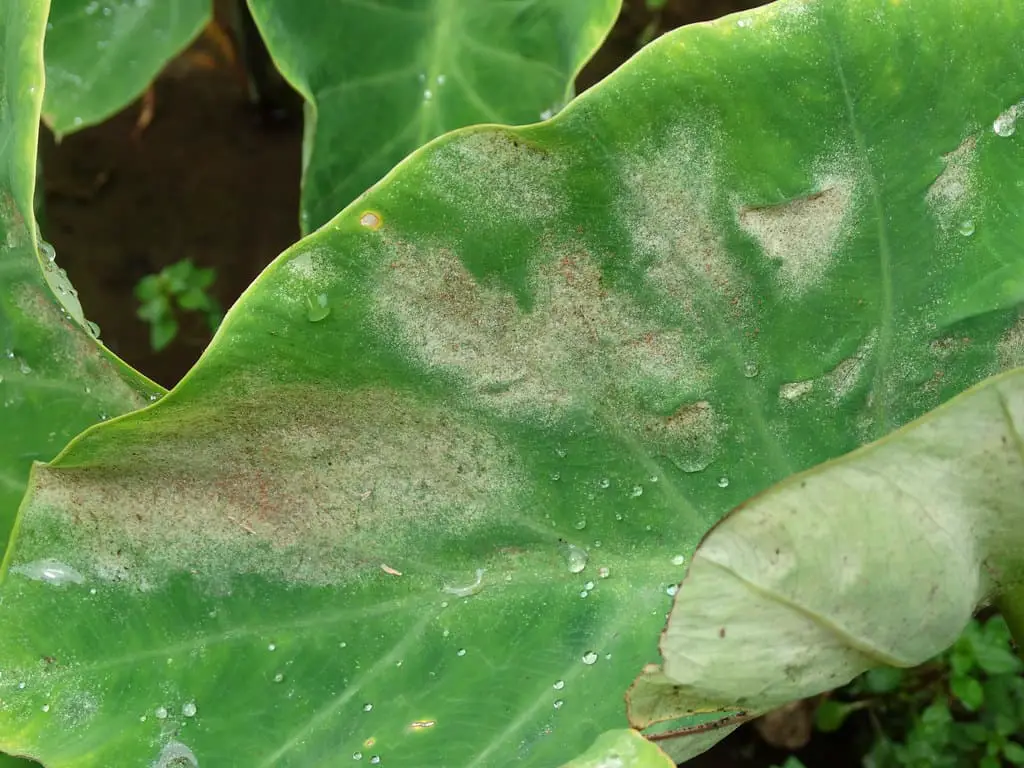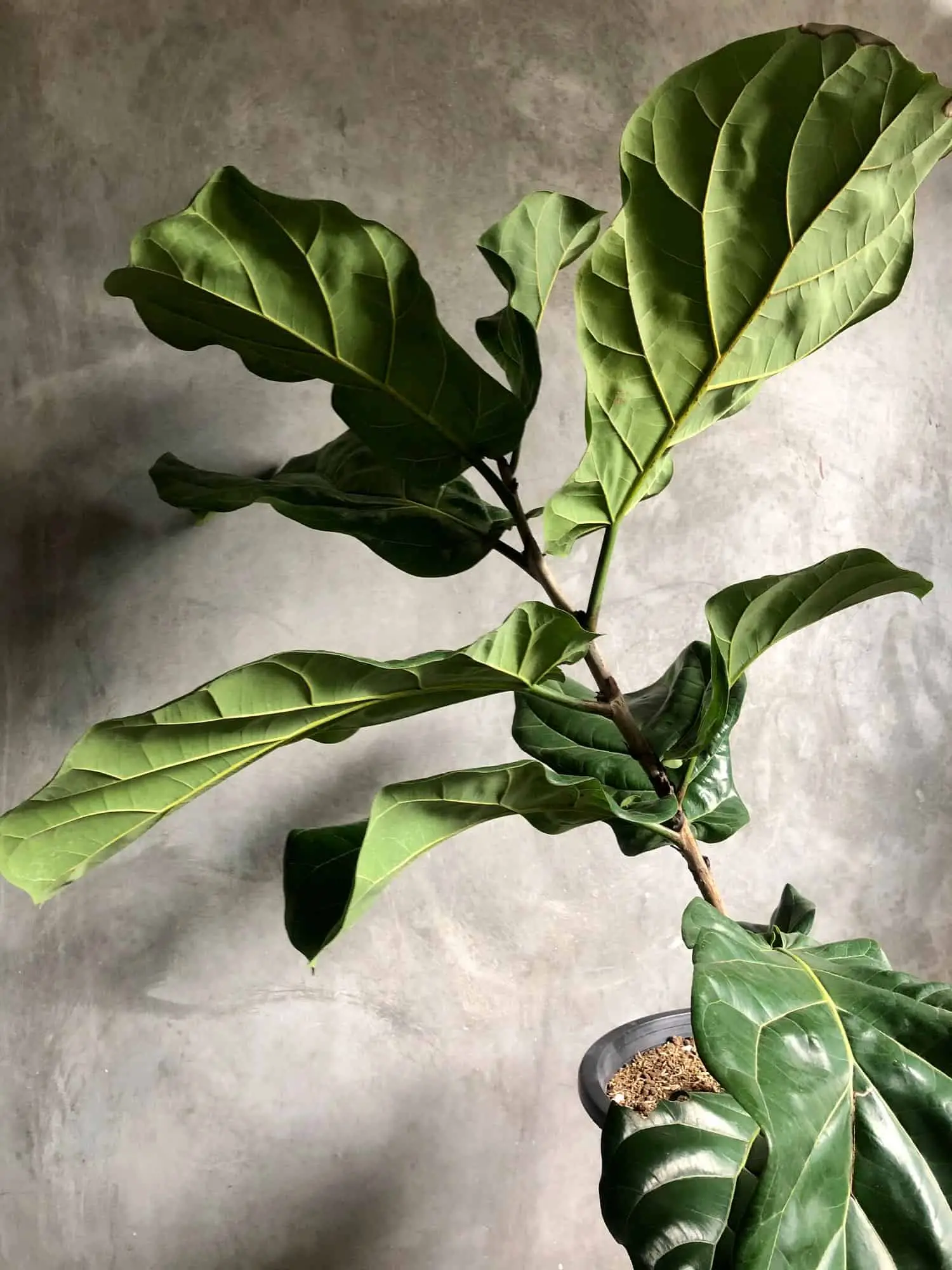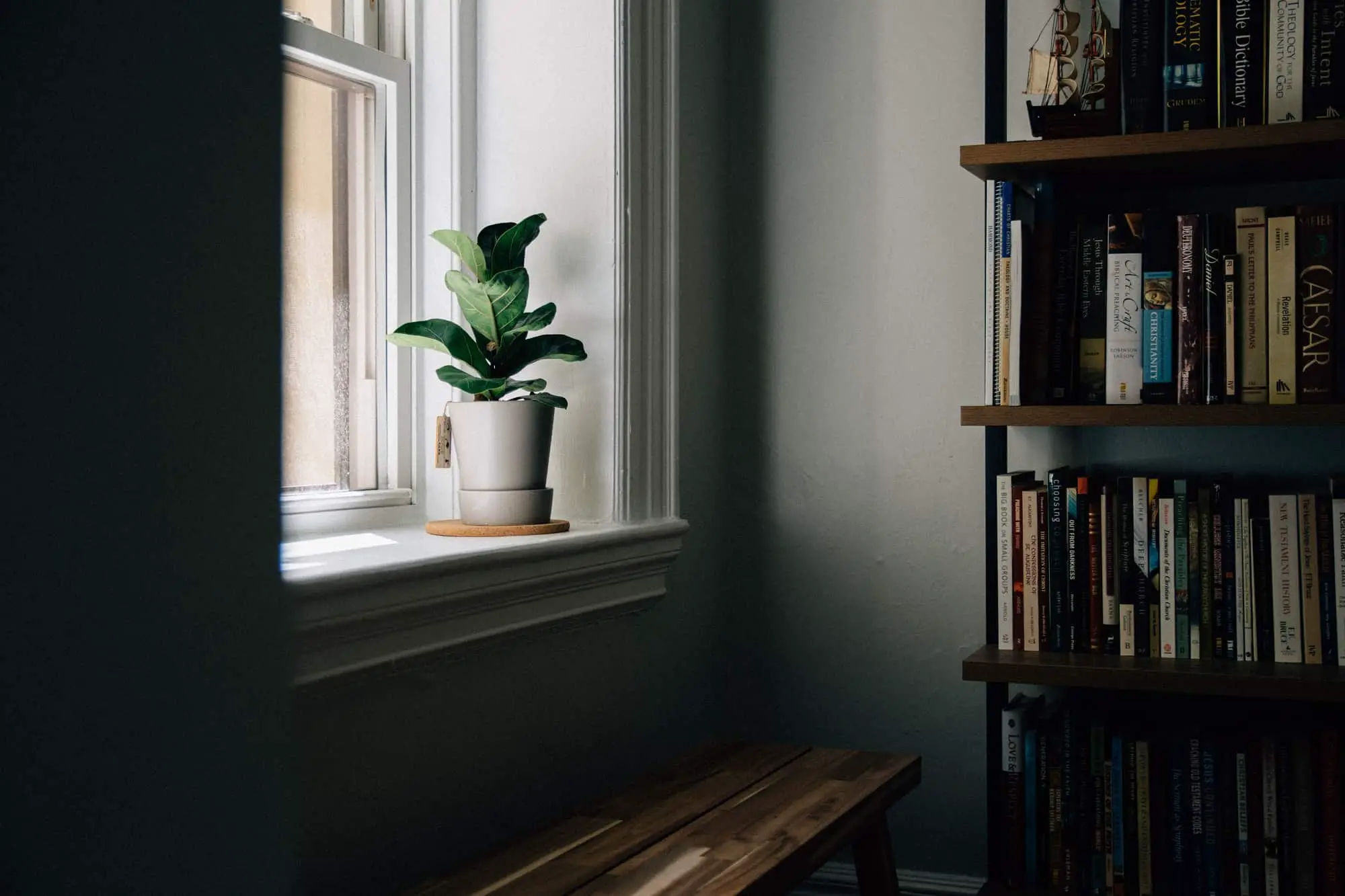Ficus lyrata, which is commonly known as Fiddle Leaf Fig, has enjoyed a resurgence in popularity over the last several years. One reason for this booming popularity is the abundance of beautiful pictures of Fiddle Leaf Fig plants on Pinterest boards and on Instagram. In addition, Fiddle Leaf Figs go well with Bohemian and mid-century modern decor, which is also really popular right now. While the Fiddle Leaf Fig is probably not a good houseplant choice for new plant parents, this plant can make an excellent addition to a more experienced plant owner’s collection. With proper care, you can also grow Fiddle Leaf Figs that look like the plants shown on your favorite Pinterest boards. The following table outlines how to care for a Fiddle Leaf Fig.
| Scientific Name | Ficus lyrata |
| Common Name | Fiddle Leaf Fig |
| Lighting Requirements | This plant needs bright light. They do best when grown next to a south-facing window. |
| Water Requirements | Keep the soil moist (not soggy). Allow the top 1-inch of soil to dry out completely between waterings. |
| Temperature | 50°F – 95°F, USDA Hardiness Zones 10-12 |
| Humidity | Relative humidity levels between 50% and 65%. Young leaves benefit from misting when they are first opening. |
| Fertilizer | Fertilize during regular watering sessions during the growing season (spring and summer) with a diluted liquid fertilizer that is high in nitrogen. The ideal NPK ratio is 3-1-2. |
| Soil | Well-draining soil mix comprised of 2 parts potting soil, 1 part pine bark mulch, and 1 part perlite. |
| Repotting | Repot every 2-3 years or if roots begin growing out of the container’s drainage holes. |
| Toxicity | Toxic to cats and dogs if ingested. |
The following blog post will discuss the Fiddle Leaf Fig’s care requirements in further detail.
About Fiddle Leaf Fig
Ficus lyrata, which is commonly known as Fiddle Leaf Fig, is a common houseplant with large leaves that have a leathery texture. Fiddle Leaf Fig is native to western Africa and spans across Cameroon all the way to Sierra Leone. This plant’s native environment is tropical and humid all year. The average annual rainfall spans from 80 inches to 120 inches.
In the wild, these plants can grow to heights of 50 feet to 70 feet. However, most houseplants will grow to a maximum height of about 10 feet.
Bambino Fiddle Leaf Fig
It may be difficult for many people who live in a small space to fit a large Fiddle Leaf Tree next to a sunny window. Fortunately, there are smaller plants called Bambino Fiddle Leaf Figs or Dwarf Fiddle Leaf Figs available for those who are not ready to put a tree in their home. Bambino Fiddle Leaf Figs are bushier and more compact than their lankier counterparts. They will grow to a maximum height of 3 feet, and Bambino Fiddle Leaf Figs have the same care requirements as regular-sized Fiddle Leaf Figs.
Lighting Requirements For Fiddle Leaf Fig
Fiddle Leaf Figs need a lot of light! In their native habitat, these plants can grow in direct sunlight or under the canopy of other trees. In general, a Fiddle Leaf Fig should be placed next to a south-facing window or the sunniest location in your home. These plants can adapt to less than ideal light conditions, but they will become even fussier when it comes to other aspects of their care!
Watering Fiddle Leaf Fig
The ideal watering routine depends on your Fiddle Leaf Fig’s size, the size of its container, the season, and the amount of light it receives in your home. As you may guess, larger plants will use more water than smaller plants. Another important thing to remember is that water will stay in larger pots for a longer period of time than smaller pots. If your Fiddle Leaf Fig is still in its nursery pot, you will have to water your plant much more often than if you repot your Fiddle Leaf Fig in a larger container. Finally, Fiddle Leaf Figs grown in darker areas will use less water. Therefore, they need to be watered less frequently.
To properly water your Fiddle Leaf Fig, apply water until the soil is moist (not soggy) and wait for the top one inch of soil to dry out completely before you water again. Fiddle Leaf Figs will use more water during its active growing season (spring and summer) than during the winter months, so it is important to check the soil moisture before watering.
If you have no idea where to start, I recommend watering your Fiddle Leaf Fig every week during the spring/summer and every two weeks during the winter months. Watch your plant for signs of underwatering/overwatering and adjust from there.
Like other houseplants, Fiddle Leaf Figs are susceptible to root rot which is typically caused by overwatering. To minimize the chance of root rot caused by overwatering, make sure you grow your Fiddle Leaf Fig in a pot that has drainage holes. This will allow excess water to flow out of the container.
Signs of Overwatering A Fiddle Leaf Fig
- The leaves have dark (almost black) spots or dark edges
- Musty smell
- Soil is saturated
- Older leaves (at the bottom) are starting to fall off of the plant
Signs of Underwatering A Fiddle Leaf Fig
- Drooping leaves
- Brown, crispy spots on the leaves
- The top two inches of soil are dry
- Young and old leaves are falling off of the plant
Fertilizing Fiddle Leaf Fig
It is important to fertilize your Fiddle Leaf Fig so the plant will continue to grow and have a healthy appearance. Signs that your Fiddle Leaf Fig needs fertilization include yellowing leaves and the bottom leaves will completely fall off of your plant. However, excessive fertilizer can cause burning.
The Fiddle Leaf Fig Plant Resource formulated a fertilizer specifically made for Fiddle Leaf Figs. It has an NPK ratio of 3-1-2. Simply use one teaspoon of this fertilizer during your regular watering sessions during the active growing season (spring and summer). Click here to view this item on Amazon. You can also use an all-purpose houseplant liquid fertilizer as long as it is diluted to quarter strength.
You do not need to fertilize your Fiddle Leaf Fig for two to three months after repotting it. This is because the new potting soil will contain enough nutrients to feed the plant for a couple of months.
Temperature and Humidity
Ideal Temperature Range For Fiddle Leaf Fig
The Fiddle Leaf Fig can tolerate temperatures between 50°F and 95°F. Most homes have indoor temperatures that fall in this range. If you live in a mild climate, it is also possible to successfully grow a Fiddle Leaf Fig outside.
Fiddle Leaf Figs can be grown outdoors in United States Department of Agriculture (USDA) Hardiness Zones 10 through 12. As you may expect, Fiddle Leaf Figs grown outdoors will grow much taller than indoor plants (assuming they are grown in an appropriate climate).
Humidity Levels For Fiddle Leaf Fig
Like other plants native to tropical rainforests, the Fiddle Leaf Fig prefers to live in a humid environment. Ideally, they should be kept in an environment with relative humidity levels between 50% and 65%. Many homes are drier than this. To increase the humidity near your plant, consider purchasing a humidifier. You can purchase a humidifier from Amazon for under $30, and it is worth the investment. Higher humidity levels will keep your plant looking healthier and will prevent brown spots from forming on the edges of the plant’s leaves.
While a humidifier will increase the humidity within the vicinity of your plant, young leaves that are just opening benefit from additional misting. Simply use a spray bottle to mist new leaves every other day.
To avoid drying out your Fiddle Leaf Fig’s leave, do not place your plant next to an air vent or air conditioning unit.
It is important to remember that these plants do not like sudden changes to their environment. If you must move your Fiddle Leaf Fig, do so during the spring/summer when the plant has more energy to push through any undesirable changes.
Best Soil Mix For Fiddle Leaf Fig
Like other houseplants, it is important to grow your Fiddle Leaf Fig in a well-draining soil in order to prevent root rot. A suitable soil mix for Fiddle Leaf Fig is comprised of 2 parts potting soil, 1 part pine bark mulch, and 1 part perlite.
Repotting Fiddle Leaf Fig
Repot when your Fiddle Leaf Fig becomes root bound. You will know that your plant is root bound if roots start growing out of the drainage holes. When you repot your Fiddle Leaf Fig, put the plant in a container that is only one size (1 to 2 inches) larger. Putting your plant in a container that is too large could result in standing water/overwatering issues because the plant will not be able to suck water up from all of the surrounding soil.
It is best to repot your Fiddle Leaf Fig during the spring or summer months. This is the plant’s growing season, so it will have more energy to push through any changes (remember this plant is fussy and doesn’t like change).
Even if the pot isn’t root bound, you should change out the soil every two or three years. This will ensure that your plant has access to plenty of nutrients. If the plant is not root bound, you do not need to put the plant in a new container.
Pruning Fiddle Leaf Fig
Pruning your Fiddle Leaf Fig has many benefits. First, it prevents the plant from growing too tall which can be an issue when growing these plants indoors. Pruning also gives you the opportunity to shape your plant and remove any dead leaves.
The following video demonstrates how to prune your Fiddle Leaf Fig.
Propagating Fiddle Leaf Fig
Propagating your Fiddle Leaf Fig gives you the opportunity to make new plants from your existing plant. You can keep propagated plants, give them away as gifts, or take them to plant swaps.
You can propagate most houseplants from stem or leaf cuttings. However, you cannot propagate a Fiddle Leaf Fig from a leaf. Although roots may develop at the end of the leaf, a rooted leaf will not grow into a mature Fiddle Leaf Fig. The steps for propagating a Fiddle Leaf Fig are as follows:
- Find a clean vase or glass and fill the glass with clean water.
- Use clean cutting shears to remove a stem cutting that contains at least two to three leaves. Take the stem cutting at least three inches below the first leaf.
- Dip the stem cutting in rooting hormone and place the cutting in the water-filled vase you prepared in Step 1.
- Place your propagation station (clean container and stem cutting) next to a sunny window.
- Change out the water every couple of days.
- After the stem cutting roots, plant your rooted plant in a container filled with moist, fresh potting soil.
Potential Pest Problems For Fiddle Leaf Fig
Like other houseplants, Fiddle Leaf Figs can experience pest problems. Some of the most common pest problems are scale insects and spider mites. This section will discuss how to handle these pest problems.
TIP: Move any pest-infested plant away from your other plants to ensure that the infestation does not spread to all of your plants!
Scale Insects On Fiddle Leaf Fig

Scale insects are a common problem for many houseplant owners. They suck the sap out of the plant leaves. Eventually, scale insects will kill the plant if a potential infestation is not addressed. Some examples of scale insects include:
- Armored scale;
- Soft Scale; and,
- Mealybugs.
One way to get rid of scale insects is to use an alcohol-soaked cotton swab to remove them from the leaves and stems. Another option is to use your finger nail to pick off the insects. Finally, insecticidal soaps effectively remove scale insects from plants.
Spider Mites on Fiddle Leaf Fig

Spider mites damage plants by feeding on the chlorophyll, which is the pigment that gives leaves their green color, in the plant leaves. As a result, spider damage will often show up as white or brown spots on your Fiddle Leaf Fig’s leaves. You may also see red and/or dark brown spots on the leaves. These small dots are spider mites. They are very small creatures (less than 1 mm)!
Another sign of spider mites is webbing on the bottom of your Fiddle Leaf Fig’s leaves. Although they are not spiders, spider mites are arachnids, meaning they are related to spiders and scorpions. Like spiders, they do spin webs.
The good news is that it is fairly easy to remove spider mites even though they are difficult to see. To remove spider mites, use a hose or shower to give your plant a good rinse. This should physically dislodge most of the spider mites. Once the leaves have dried, use a spray bottle to thoroughly apply a mixture of neem oil and water to the plant’s leaves. Apply the neem oil mixture to your plant’s leaves every 4-5 days until there are no more signs of spider mite damage. Spider mites reproduce quickly, so this process may take a couple of weeks.
The Importance Of Cleaning Your Fiddle Leaf Fig’s Leaves
Like other plants with large leaves, dust builds up fairly quickly on the leaves of a Fiddle Leaf Fig. In their native habitat, tropical storms wash the excess dirt off of the leaves of a Fiddle Leaf Fig. However, houseplants need our to help to keep the leaves clean.
Why are dirty leaves a problem? Not only do dusty leaves have an unsightly appearance, dust can actual inhibit your plant’s normal physiological functions. For example, dust will block sunlight and decrease the rate of photosynthesis. This inhibits the plant’s ability to feed itself.
To clean your Fiddle Leaf Fig’s leaves, you can wipe down the leaves with a damp cloth. This method of cleaning also serves as a detailed inspection that can help you identify any potential pest or disease problems. Alternatively, you can use your hose or shower to rinse off the plant’s leaves.
Avoid rubbing oils or other products on your plant’s leaves. They may give the leaves a nice shine, but oils do more harm than good. Putting oils or other products on your plant’s leaves can result in a film that significantly inhibits your plant’s ability to breathe.
Is Fiddle Leaf Fig Toxic?
Fiddle Leaf Fig is toxic if the leaves are ingested because, like many other houseplants, this plant contains insoluble calcium oxalates.
Calcium oxalates can cause oral irritation, excessive drooling, vomiting, and difficulty swallowing. This is because calcium oxalates are tiny, needle-like crystals that will embed themselves in the oral cavity if an animal chews the leaves. If you believe your pet has ingested a Fiddle Leaf Fig or another houseplant, consult your veterinarian.



